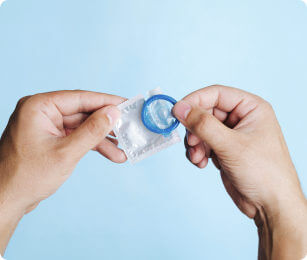Sexually transmitted infections (STIs) are a significant global health issue. In the Netherlands, the incidence of various STIs increased again in the past year: 21% of all STI tests conducted at Sexual Health Centers tested positive, marking an increase compared to previous years. Some STIs can have serious health consequences. Therefore, it is important to be well-informed about the different ways you can contract an STI, how to find out if you have one, and how to treat it. Read on for answers to these questions.


What is an STI and how do you get one?
An STI, or sexually transmitted infection, is a collective term for various infections transmitted through sexual contact. These conditions can be caused by bacteria, viruses, or parasites, ranging in severity from mild to severe, and can be transmitted in various ways from person to person. There are numerous STIs, including chlamydia, gonorrhea, syphilis, HIV, herpes, genital warts, trichomonas, and hepatitis B. Each STI has its own characteristic symptoms and potential complications. For instance, some STIs like chlamydia and gonorrhea can lead to pain during urination and discomfort in the genital area, while others like HIV can cause severe issues with the immune system, ultimately progressing to AIDS if left untreated.
Now that you are aware of the existence of various STIs, it’s crucial to understand how one contracts an STI. How do you get an STI?
- Unprotected sexual intercourse: Engaging in vaginal, anal, or oral sex without the use of a condom or another barrier method can lead to contracting an STI. This is the most common way STIs are spread.
- Sexual contact with infected bodily fluids: STIs can be transmitted through contact with infected bodily fluids such as blood, semen, vaginal discharge, and rectal secretions. This can occur during sexual contact, sharing needles in drug use, or in rare cases, from mother to child during childbirth.
- Direct skin-to-skin contact: Some STIs, like herpes and genital warts, can be transmitted through direct skin-to-skin contact with infected areas. This doesn’t apply to all STIs.
- Use and sharing of sex toys: While the risk is low, sharing sex toys without thorough cleaning between uses with different partners can lead to the spread of STIs.

Can you contract an STI if your partner doesn't have one?
If your partner doesn’t have an STI, there is no risk of contracting one. However, it’s essential to note that some STIs can be asymptomatic, meaning that an individual is contagious but does not experience any symptoms. It is also possible for someone to carry a virus without exhibiting symptoms. In such cases, the person is already contagious and can unknowingly transmit an STI. Additionally, certain STIs, like genital warts and genital herpes, can be transmitted through skin-to-skin contact alone.


The aforementioned situations can lead to the transmission of various STIs. There are also plenty of situations in which you face a low or even negligible risk of contracting an STI. These forms of intimacy carry a negligible risk of an STI:
- Masturbation: Masturbating without the involvement of an infected partner poses no risk of STI transmission.
- Kissing: Kissing someone usually does not carry a risk of an STI. There are some exceptions, such as herpes, which can be spread through mouth-to-mouth contact if someone has symptoms.
- Non-sexual skin-to-skin contact: Non-sexual touches, like holding hands, hugging, or cheek kissing, do not pose a risk of an STI.



It is crucial to be aware of the ways in which STIs are spread to prevent contracting one. Safe sex practices, regular STI screening, and open communication with your sexual partners are essential steps to reduce the risk of STI infection. But how do you find out if you have an STI?
How do you know if you have an STI?
The symptoms of an STI can vary depending on the type you have contracted. Some STIs may not present immediate symptoms or can even be entirely asymptomatic, meaning you experience no symptoms but are still contagious.
When an STI does cause symptoms, you may notice the following:
- Pain during urination: This could indicate chlamydia or gonorrhea.
- Itching or rash in the genital area: This may suggest genital herpes or pubic lice.
- Discharge from the penis or vagina: Abnormal discharge can be a sign of various STIs, including gonorrhea.
- Sores or ulcers: These may appear with syphilis or herpes.
- Swollen lymph nodes: This can occur with almost any STI.
- Fever and fatigue: These symptoms can occur with HIV.




Would you like to know more about the symptoms of different STIs? We’ve written a separate blog detailing the symptoms for each STI. If you experience symptoms that could indicate an STI, it is crucial to get tested as soon as possible. At Easly, we offer various STI tests. Take the Easly STI test guide, order your personal STI test, and find out if you need treatment. It’s important to note that some STIs may show no symptoms at all, which is why regular testing is crucial when sexually active.
How likely is it to get an STI?
The likelihood of contracting an STI varies and depends on various factors. Some individuals are at a higher risk of getting an STI due to risky behaviors they engage in. Therefore, it is wise to consider the following points when wondering if you might have an STI:
- Have you engaged in risky behavior? Risky sexual behavior includes having unprotected sexual contact, having multiple sexual partners, or engaging in sexual contact with someone who has an STI.
- Regular check-ups: Regardless of whether you have symptoms, it is advisable to undergo regular STI tests if you are sexually active. This is especially important if you have engaged in risky behavior. When was the last time you had an STI test? Have you and your (new) partner undergone STI testing?

Do you want to know if your symptoms are caused by an STI? Or do you want to undergo a periodic check-up? Take the Easly STI test guide, order the appropriate STI test, and easily and reliably conduct the test at home.
Related tests

Treatment of an STI
When you test positive for an STI, it is crucial to promptly and appropriately treat the infection. Some STIs, such as gonorrhea, chlamydia, HIV, and hepatitis B, can potentially have (serious) health consequences if left untreated. Moreover, rapid treatment is essential to prevent further spread of the STI. The treatment may vary depending on the type of STI, the severity of the infection, and individual circumstances. Here are some general points about the treatment of STIs:
- Antibiotics and antiviral medications: Many bacterial STIs, such as chlamydia, gonorrhea, and syphilis, can be effectively treated with antibiotics. It is important to take the prescribed medication according to your doctor’s instructions, even if the symptoms disappear. For viral STIs like herpes and HIV, antiviral medications are available to manage symptoms and slow the progression of the disease, but these infections are generally not curable. After being treated for an STI, you may need to refrain from unprotected sexual contact for a specific period. Consult your doctor to determine the duration for the specific STI.
- Partner notification and treatment: If you have an STI, it is essential to inform all your sexual partners so that they can get tested and treated. This helps prevent further spread of the infection and protects the health of others.
- Health education and prevention: Treatment of STIs should go hand in hand with preventive measures. Preventive measures include safe sex practices, vaccinations for certain STIs (such as HPV), and avoiding risky sexual behavior.




Prevention of an STI
The good news is that most STIs can be prevented. Safe sex practices, such as using condoms, are an effective way to reduce the risk of contracting an STI. However, using a barrier method, like a condom, does not provide a 100% guarantee against acquiring an STI. Therefore, it is important to undergo regular testing if you are sexually active, especially if you have changed sexual partners or have new partners. Below are some measures to minimize your risk of an STI:
- Safe sex: Using condoms or other barrier methods during sex is an effective way to reduce the risk of STIs. Condoms offer protection against the transmission of infections such as chlamydia, gonorrhea, and HIV. It is crucial to use condoms correctly and consistently, especially with changing sexual partners. Condoms are (almost) ineffective against the transmission of herpes and genital warts.
- Vaccinations: Vaccinations are available to prevent some STIs. For example, the HPV vaccine provides protection against the human papillomavirus, which can cause genital warts and certain forms of cancer. There is also a vaccine available for hepatitis B.


- Testing: Regular STI tests, especially for individuals engaging in risky sexual behavior, contribute to early diagnosis and treatment. This is important because some STIs, such as chlamydia and gonorrhea, often progress asymptomatically.
- Taking responsibility: Taking responsibility for your own sexual health and adopting preventive measures are crucial steps in preventing STIs. Additionally, it is important to notify your previous sexual partners if you test positive for an STI to prevent further spread.
Conclusion
There are many different types of STIs that can be transmitted in various ways. When sexually active, it is essential to be aware of how STIs are transmitted and how they can be prevented and treated. By practicing responsible sexual behavior and undergoing regular STI testing (for example, through Easly’s STI tests), you can protect yourself and others from these infections and reduce their potential consequences. Are you experiencing symptoms that may indicate an STI? Schedule an appointment with your doctor and/or get tested!









